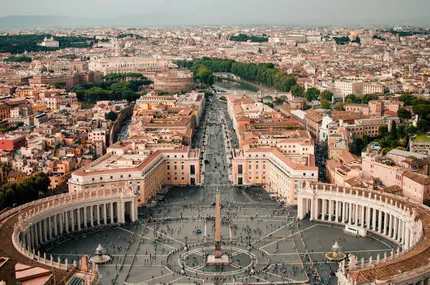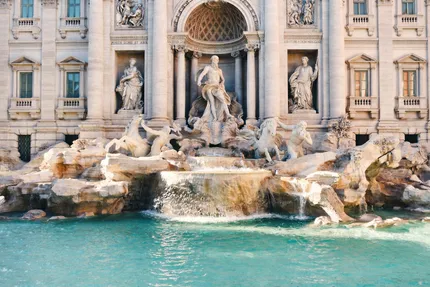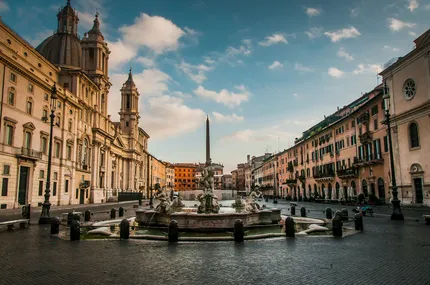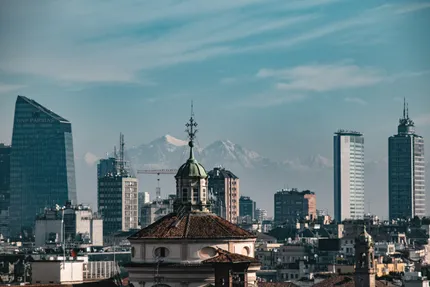CityTouring

City trip to Rome
ItalyRome, the capital city of Italy, is a mesmerizing blend of ancient history and vibrant modernity. Known as the Eternal City, Rome effortlessly transports visitors back in time with its awe-inspiring landmarks such as the Colosseum, the Roman Forum, and the magnificent Pantheon. Each corner of the city echoes with stories of emperors, gladiators, and philosophers, making it an unparalleled destination for history enthusiasts.
But Rome is not just about the past, as its lively streets are filled with bustling cafes, world-class restaurants, and charming boutiques. Wandering through the narrow lanes of Trastevere or indulging in authentic Italian gelato at the Trevi Fountain adds a different charm to the city's experience. Art lovers will find themselves immersed in masterpieces in the Vatican Museums and the grandeur of St. Peter’s Basilica. Rome's rich culture, coupled with its contagious zest for life, attracts a diverse range of visitors year-round.

Colosseum
Iconic ancient amphitheater offering a glimpse into Rome's gladiatorial past, with impressive architecture and history.

St. Peter's Basilica
Majestic Renaissance church in Vatican City, featuring Michelangelo's Pietà and exquisite architectural details.

Trevi Fountain
Famous Baroque fountain where visitors toss coins to ensure their return to Rome. Stunning sculptures adorn this site.
Rome is an ideal destination for history buffs, art enthusiasts, and food lovers. The city serves as a playground for those fascinated by ancient civilizations, with landmarks like the Colosseum and the Roman Forum providing a vivid glimpse into the past. Art aficionados will be captivated by the abundance of Renaissance and Baroque masterpieces scattered throughout the city, while foodies can relish in the culinary delights of Italian cuisine, from traditional trattorias to Michelin-starred dining.
Families will appreciate Rome’s rich educational experiences combined with fun activities like the gladiator school experience for kids. Couples looking for a romantic getaway will find that Rome offers charming strolls and picturesque piazzas. The city's vibrant culture and historic allure present an unforgettable city break for urban explorers and culture seekers.

Best time to visit Rome
The best time to visit Rome is during the spring (April to June) or fall (September to October). These months offer mild weather and fewer crowds compared to the bustling summer season, making it perfect for leisurely exploration and enjoying outdoor terraces.
More activities and things to see in Rome:
Vatican Museums
Renowned museums housing the vast art collection of the Roman Catholic Church, including the Sistine Chapel.
Pantheon
Well-preserved ancient Roman temple featuring a beautiful dome and oculus, now a church with an illustrious history.
Roman Forum
Historic site that was the center of public life in ancient Rome, featuring ruins of important government buildings.
Spanish Steps
Elegant set of steps leading to the Trinità dei Monti church, popular for people-watching and enjoying the ambiance.
Borghese Gallery
Art museum located in Villa Borghese, showcasing masterpieces by Caravaggio, Raphael, and Bernini in a lush garden setting.
Piazza Navona
Vibrant square with Baroque fountains, street artists, and lively cafes, built on the site of an ancient stadium.
Castel Sant'Angelo
Historic castle originally built as a mausoleum for Emperor Hadrian, later used by popes, offering panoramic views.
Trastevere
Charming neighborhood known for its narrow, winding streets, lively nightlife, and authentic Roman dining experiences.
Campo de' Fiori
Lively square featuring a bustling morning market with fresh produce and flowers, and a vibrant ambiance in the evenings.
Getting around in Rome
Rome is a city best explored on foot, thanks to its many pedestrian-friendly streets and abundance of historical sites within walking distance. The public transportation system, which includes buses, trams, and metro, is extensive and reasonably priced, making it easy to navigate the city without a car. The metro has three main lines, with Line A and Line B intersecting at Termini Station, the central hub. For added convenience, Rome offers bike-sharing services, ideal for navigating its picturesque roads. While driving in Rome can be challenging due to heavy traffic and limited parking spaces, it’s largely unnecessary for getting around the main attractions. Taxis and ride-sharing services are also available but can be pricey compared to public transport options. Overall, utilizing Rome's public transit and exploring on foot or by bike are the most efficient and cost-effective ways to experience the city.
Getting to Rome
Rome is well-connected internationally, with Leonardo da Vinci International Airport (Fiumicino) being the main gateway for international flights, located about 30 kilometers from the city center. It offers numerous connections to major cities worldwide. Ciampino Airport, primarily serving budget airlines, is another option closer to the city. From both airports, you can reach the city center by train, bus, or taxi. Rome's Termini Station is the main railway hub, providing high-speed train connections to many European cities, including direct routes to Florence, Milan, and Naples. For intercity travel within Italy and beyond, long-distance buses operate from Tiburtina Station, offering economical options, including routes to nearby countries. Overall, Rome is highly accessible by air and train, ensuring a smooth arrival for international and domestic travelers.



